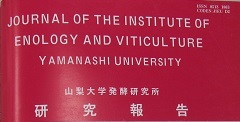

 |
山梨大学醗酵研究所 研究報告[1954年-1991年] JOURNAL OF THE INSTITUTE OF ENOLOGY AND VITICULTURE |
| vol.26 (1991) |
|
Decomposition of Bound Sulfite into Free Sulfite and Determination of Total Sulfite in Wine Using a Microbial Sensor Hiroshi Kurosawa, Kazuo Nakamura, Yoshifumi Amano, Takeshi Sato, Nobuko Kubo, Hirofumi Akano, and Yoshiya Kawamura (Department of Applied Chemistry and Biotechnology, Faculty of Engineering, Yamanashi University, Nakano Vinegar Co. Ltd., Japan) pp.1-4.[PDF] |
| Total sulfite in wine was determined by use of a microbial sensor consisting of a sulfur-oxidizing autotrophic bacterium(Thiobacillus thiooxidans JCM7814) and an oxygen electrode.Although this microbial sensor selectively detected free sulfite,it could not directly apply to the determination of total sulfite.When the microbial sensor method was applied for the determination of total sulfite,bound sulfite had been previously decomposed into free form by treating with alkaline or acid.By treating wine samples with 4NKOH for 5min at room temperature,the microbial sensor could determine total sulfite in wines with similar accuracy to the modified Rankine method.The recoveries of total sulfite were 95.5% and 100% in white wine and red wine,respectively.Good recoveries were attained in the same manner by treatment with heating at 85℃ for 10min under acid condition of 0.5 NH2SO4. |
|
「鮭白子から抽出した塩基性ペプチドの抗菌性」
Antimicrobial Activity of Basic Peptides extracted from Salmon Roe with Hydrochloric Acid 野崎一彦・松土俊秀・中島智恭・矢嶋瑞夫・横塚弘毅 Kazuhiko Nozaki, Toshihide Matsud, Tomoyoshi Nakajim, Mizuo Yajim, and Koki Yokotsuka (Asama Chemical Co.,Ltd., Institute of Enology and Viticulture, Yamanashi University) pp. 5-16[PDF] |
|
鮭の白子を塩酸抽出し、中和後脱塩して、塩基性ペプチド混合物を得た。この抽出物をSephadex G-25クロマトグラフィーにより分別すると大きく4つの画分に分かれ、さらにこれらをSephadex G-15, G-25, G-50を用いたゲルクロマトグラフィーによって10の画分に分けた。得られたペプチド画分についてアミノ酸分析を行い、またゲルクロマトグラフィーとDNP法による末端アミノ酸分析によって分子量測定を行った。その結果、これらのペプチドはいずれも塩基性ペプチドであるが、末分解の完全な構造を有するプロタミン分子は含まれておらず、プロタミン分解ペプチドやプロタミン以外の塩基性タンパク質あるいはペプチドが含まれていた。これらのペプチド画分の中、ゲルクロマトグラフィーで排除容量付近に溶出される画分には中程度の抗菌活性が認められたが、排除容量位置に溶出されたピークと最も遅く現れるピークとの中間に溶出された画分には抗菌性はほとんどなく、最後に溶出される画分が最も強い抗菌性を示した。これらの結果、抗菌性の発現には完全なプロタミン分子は必要なく、ある特定のアミノ酸配列をもつペプチドが抗菌性と深く関与していることが分かった。 Basic peptides were extracted from salmon roe with dilute hydrochloric acid.The peptides were separated into four fractions by Sephadex G-25 chrom atography.Each of the fractions was further separated by Sephadex G-50,G 25,or G-15 chromatography,and ten basic peptide fractions with different molecular weights and amino acid compositions were obtained.An intact protamine fraction was not contained in the extract.The antimicrobial activity of the fractions obtained was tested with microorganisms found commonly in foods of these fractions,those eluted early on Sephadex chromatography had appreciable antibacterial activity,while those eluted late had the highest activity;the fractions eluted in the middle of the above fractions had little activity.The results suggested that the complete structure of protamine was not needed in order to reveal its antimicrobial activity,and certain specific amino acid sequences contributed to the activity. |
|
「寒天重層発酵法による低温発酵性ワイン酵母の選択」 Double Layer Agar Fermentation Method for Selection of Cryophilic Wine Yeasts 後藤昭二・岸本宗和・篠原 隆(山梨大学工学部発酵化学研究施設) Shoji Goto, Munekazu Kishimoto, and Takashi Shinohara (Institute of Enology and Viticulture) pp.17-20[PDF] |
|
低温発酵性ワイン酵母の選択に簡便、有用な寒天重層発酵試験法を開発した。中型試験管に下層培地として寒天0.25%のPYG-F培地を注入し、層高を60mmとする。これに酵母を接種後、2%寒天を厚さ10mmに重層した。発酵ガスによる重層2%寒天層の経時的な上昇距離から発酵状態を判定した。 A double layer agar fermentation method was developed for the selection of cryophilic wine yeasts. An underlying medium,PYG-F(Peptone-Yeast Extract-Glucose)containing 0.25% agar is poured into a medium-sized test-tube to give a lower layer 60mm in height.After yeast is inoculated into this lower layer medium,it is covered with 2% agar with a thickness of 10mm.The fermentation velocity is evaluated by measuring the distance the upper layer of agar rises as a result of fermentation gas. |
|
「酵母のGC含量測定のための新しい菌体破壊法」 A New Method of Cell Disruption for Analysis of GC Content in Yeast 長沼孝文・服部憲晃・兎束保之 Takafumi Naganuma, Noriaki Hattori, and Yasuyuki Uzuka (Department of Applied Chemistry and Biotechnology, Faculty of Engineering) pp.21-26[PDF] |
|
Lipomyces属酵母のGC含量測定のための新しい菌体破壊法の開発を行った。試験管にガラスビーズと菌体を入れ、タワー型ミキサーを用いて振盪破壊する新しい方法は、これまで用いられてきた同じ機械的破壊法であるBraun homogenizer法よりもDNAの回収が良好であった。また、同じく既存の方法であるZymolyase溶菌法に比べて、多糖などの夾雑物の混入量が少なく、この方法で再現性が得られにくい菌株でも、新しいMix-Tower法では信頼性の高い分析値が得られた。 A new method of yeast cell disruption for GC content analysis in DNA was developed. In the new method, cells in a test tube containing glass beads were disrupted with a tower-shaped mixer, making this experimental operation simpler. This new method has the advantage of high recovery of DNA and inhibitting polysaccharides contamination into the DNA. The GC contents in yeasts disrupted by the new method agreed well with those obtained by the established method. |
|
「交雑新品種・赤ワイン用ブドウ'ヤマ・セミヨン'(ヤマブドウ×セミヨン)の品種特性について」 Characterization of Hybrid New Red-Wine Grape Cultivar ‘Yama Sémillon’(Japanese Wild Grape x Sémillon) 山川祥秀、田中浩毅 (山梨大学工学部発酵化学研究施設) Yoshihide Yamakawa and Hiroki Tanaka (Expermental VineyardInstitute of Enology and Viticulture, Yamanashi University) pp.27-34[PDF] |
|
The hybrid red-wine grape cultivar “Yama Sémillon” was selected and recommended due to the following characteristics : (1) no cracking of berry ; (2) resistance to ripe-rot, downy mildew, and gray mold ; (3) suitability for cultivation under the weather conditions prevailing in Japan ; (4) high productivity ; (5) high quality wine with typical aroma and taste. Origin: Japanese original wild grape variety “Yama Budou” (Vitis coignetiae) X the superior white wine grape variety of Bordeaux region "Sémillon" (Vitis vinifera). Description: Mature leaf: cordate shape,large(273cm),three lobes,flat, green, shape of leaf tip medium about 60°,petiole sinus U-shaped,open,color of petiole dark red,density of prostrate hairs between the lower side veins medium. Cluster and Berry:long conical shape,medium (205g),low berry density,berries small (1.4g),roundish-shaped,color of skin violet black at maturity,strong bloom,high sweetness of flesh juice (more than 20%),high acidity (less than 0.8%). Ecotype: early bud burst time (mid-April), early flowering time(late May), and medium maturing time(early or mid-September)at Kofu,no cracking of berry,high productivity (more than 2ton/10a),resistance to ripe-rot, downy mildew and gray mold. |
|
「酒類中のカルバミン酸エチルの生成」
Ethy1 Carbamate Formation in Alcoholic Beverages 篠原 隆 (山梨大学工学部発酵化学研究施設 ) TAKASHI SHINOHARA(Institute of Enology and Viticlture, Yamanashi University) pp.35-37[PDF] |
| The presence of ethy1 carbamate (EC) in wine,sake,liqueurs and spirits is a relatively new problem.EC is a natural product,whose strength is expresssed in micrograms per liter,which has been found to exhibit carcinogenic activity in laboratory animals.A conseiderable amount of ressearch has been conducted at a number of insistutions; urea and cyanate have been determined as the major sources of EC.This review summarizes research reports on the EC content in alcoholic beverages,regulation of the content,sources,formation and evolution,prevention and elimination of EC,and its toxicity. |
The Institute of Enology and Viticulture, University of Yamanashi 所在地:〒400-0005 山梨県甲府市北新1丁目126 |
ホ-ムペ-ジに掲載の文章・記事・写真・図表などの無断転載を禁止します。